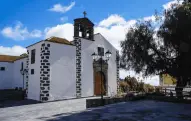The Calima: A Mysterious Phenomenon in the Canary Islands
 The Canary Islands, renowned for their idyllic climate and picturesque landscapes, occasionally experience a unique weather phenomenon known as the "calima." This atmospheric event, characterized by a dense cloud of dust originating from the Sahara Desert, brings with it a mix of beauty and inconvenience. Understanding the calima's origins, effects, and the science behind it reveals the intricate interplay between nature and weather patterns in this captivating archipelago.
The Canary Islands, renowned for their idyllic climate and picturesque landscapes, occasionally experience a unique weather phenomenon known as the "calima." This atmospheric event, characterized by a dense cloud of dust originating from the Sahara Desert, brings with it a mix of beauty and inconvenience. Understanding the calima's origins, effects, and the science behind it reveals the intricate interplay between nature and weather patterns in this captivating archipelago.
What is the Calima?
The calima is a meteorological phenomenon where strong winds from the Sahara Desert transport vast amounts of dust and sand across the Atlantic Ocean to the Canary Islands. These winds, typically the result of a high-pressure system over the Sahara and a low-pressure system over the Canary Islands, create a pathway for the dust to travel. The result is a hazy, sometimes oppressive, layer of fine particles that can envelop the islands for days or even weeks.
Origins and Mechanism
The Sahara Desert, located in North Africa, is the world's largest hot desert, and it frequently experiences intense windstorms. When these storms occur, they lift millions of tons of dust and sand into the atmosphere. The trade winds, combined with the region's specific atmospheric conditions, then carry this dust westward over the Atlantic.
During a calima event, the air in the Canary Islands becomes noticeably warmer and drier, as the Saharan dust absorbs and retains heat. Visibility can be significantly reduced, and the sky takes on a reddish or orange hue due to the scattering of sunlight by the dust particles.
Impact on Daily Life
The calima affects various aspects of life in the Canary Islands:
-
Health: The fine dust particles can pose health risks, particularly for individuals with respiratory conditions such as asthma or chronic bronchitis. The airborne dust can irritate the eyes, throat, and lungs, leading to discomfort and potential exacerbation of pre-existing health issues. Local health authorities often advise residents to stay indoors and use air purifiers during severe calima events.
-
Environment: The dust from the Sahara can impact the local environment in both positive and negative ways. While it may temporarily reduce visibility and create a dusty atmosphere, it also brings essential nutrients to the islands' ecosystems. The mineral-rich dust acts as a natural fertilizer, enriching the soil and supporting plant growth.
-
Transportation: Air travel can be significantly disrupted during a calima, with reduced visibility and dust accumulation on runways posing challenges for pilots and airport operations. Additionally, road transportation can be affected, with drivers needing to exercise caution due to decreased visibility.
-
Tourism: For tourists, the calima can be a mixed experience. While the unique atmospheric conditions can create dramatic and photogenic scenes, the dust can also be a nuisance, limiting outdoor activities and reducing the appeal of the usually clear, sunny skies of the Canary Islands.
Adaptation and Preparedness
Over the years, residents of the Canary Islands have developed ways to cope with and adapt to the calima. Building designs often include features that minimize dust infiltration, and public awareness campaigns provide guidance on staying safe during severe events. Schools and workplaces may adjust schedules or activities to reduce exposure to the dust.
Local authorities also monitor air quality closely during a calima, issuing warnings and advisories to keep the public informed. Technological advancements in weather forecasting have improved the ability to predict calima events, allowing for better preparation and response.
Scientific Interest and Research
The calima has attracted significant scientific interest, with researchers studying its effects on climate, health, and the environment. Understanding the movement of Saharan dust and its impact on distant regions contributes to broader knowledge about global weather patterns and atmospheric processes.
For instance, studies have shown that Saharan dust can influence weather conditions far beyond the Canary Islands, affecting the Caribbean and even parts of North and South America. Research also indicates that these dust particles can play a role in the formation of hurricanes and other weather phenomena.
The calima is a fascinating and complex phenomenon that exemplifies the dynamic relationship between the Sahara Desert and the Canary Islands. While it brings challenges and discomfort, it also highlights the interconnectedness of our planet's ecosystems and weather systems. By understanding and adapting to the calima, the residents and visitors of the Canary Islands can appreciate the unique beauty and resilience of this remarkable archipelago.












































